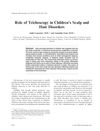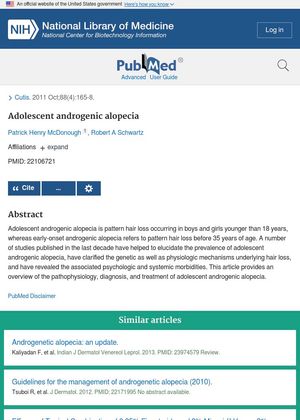TLDR Teen hair loss is common, can be caused by genetics or health issues, and can be diagnosed and treated.
The document "Adolescent androgenic alopecia" from 2011 discussed pattern hair loss in individuals younger than 18 years, and early-onset androgenic alopecia, which refers to pattern hair loss before 35 years of age. The studies published in the decade prior to the document's publication helped clarify the prevalence of adolescent androgenic alopecia, the genetic and physiological mechanisms underlying hair loss, and the associated psychological and systemic morbidities. The document provided an overview of the pathophysiology, diagnosis, and treatment of adolescent androgenic alopecia.
 32 citations
,
August 2015 in “Anais Brasileiros de Dermatologia”
32 citations
,
August 2015 in “Anais Brasileiros de Dermatologia” Black women's unique hair characteristics and styling practices can lead to specific scalp conditions, which require early diagnosis and appropriate treatment.
 43 citations
,
August 2013 in “Pediatric Dermatology”
43 citations
,
August 2013 in “Pediatric Dermatology” Trichoscopy is good for diagnosing and monitoring hair and scalp problems in children but needs more research for certain conditions.
July 2013 in “DeckerMed Medicine” The document's conclusion cannot be provided because the document is not readable or understandable.

Alopecia areata, a type of hair loss, may be passed through T cells and has genetic links, while treatments vary in effectiveness. Male pattern baldness can be treated with finasteride and is influenced by androgens in hair follicles.
12 citations
,
February 2008 in “CRC Press eBooks” The document explains different hair and scalp conditions and their treatments.
189 citations
,
May 1991 in “Medical Entomology and Zoology” 31 citations
,
January 1981 PUVA-therapy is not very effective for severe hair loss types like alopecia totalis or universalis.




